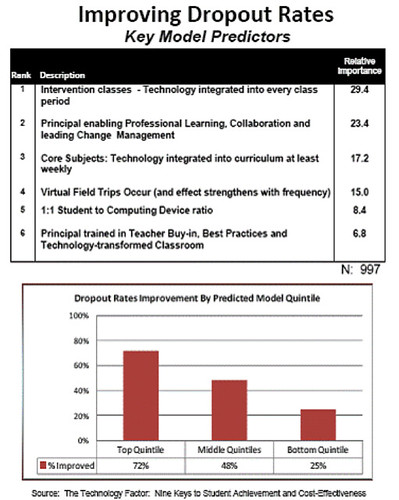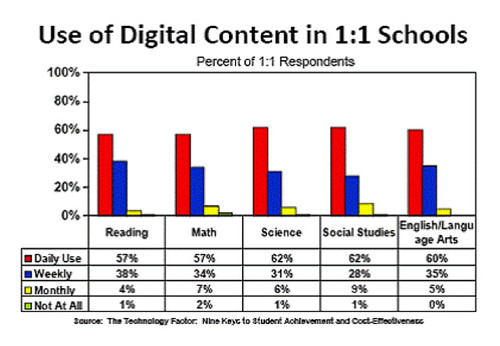| A Synopsis of Project RED | |
| Author: Leslie Wilson, Project RED | May 11th, 2011 | |
|
"Technology can play a huge role in increasing educational productivity, but not just as an add‐on or for a high‐tech reproduction of current practice. Again, we need to change the underlying processes to leverage the capabilities of technology. The military calls it a force multiplier. Better use of online learning, virtual schools, and other smart uses of technology is not so much about replacing educational roles as it is about giving each person the tools they need to be more successful--reducing wasted time, energy, and money. By far, the best strategy for boosting productivity is to leverage transformational change in the educational system to improve outcomes for children. To do so, requires a fundamental rethinking of the structure and delivery of education in the United States." -- The New Normal: Doing More With Less-Remarks of U.S. Secretary of Education Arne Duncan at the American Enterprise Institute panel, "Bang for the Buck in Schooling" November 17, 2010. The Obama administration is working to lead a bi-partisan re-authorization of the Elementary and Secondary Education Act (ESEA, (also known as No Child Left Behind or NCLB), launched in 1965. The reauthorization has been 'pending' since 2007. While there seems to be genuine interest in ensuring meaningful technology integration in schools through this federal program, the debate continues around providing 'targeted' versus 'merged' entitlement funds. We know the challenging statistics: * 25% of kids drop out of high school.* Students from low-income households are most likely to drop out. * Dropouts are more likely to go to prison than to college. There is a plethora of education research studies that address these important issues. One recent study may cause policy-makers who are looking at the re-authorization of ESEA/NCLB to say, "Here are research findings that can make a difference." The Project RED Team recently released its study, The Technology Factor: Nine Keys to Learning Achievement and Cost-Effectiveness. A key finding is that students in intervention classes--special education, reading intervention, Title I, and English Language Learners--with technology integration- do better on almost every measure of education success. Using technology in every intervention class is the single largest predictor of academic improvement of the 997 respondents to the Project RED survey. Use of technology in every class accounts for 25% of the improvement reported by principals who noted gains in academic achievement. * 29.4% of the reduction in dropout rates * 8.0% of the improvement in test scores * 25.7% of the improvement in graduation rates * 24.8% of the reduction in disciplinary actions The Project RED study used a predictive modeling analysis for examining the data. Respondents, primarily principals in public schools, were asked to report frequency (daily, weekly, etc.) of use of technology in a variety of classes, including math, science, English, and social studies and in intervention classes (special education, reading intervention, Title I classes, and English Language Learners). Principals were asked what education success measures (ESMs) had improved through the use of technology. These measures included four areas that could be objectively quantified and are most often recorded by schools: 1. Dropout rates 2. High-stakes test scores 3. Graduation rates 4. Disciplinary actions The Project RED team isolated uses of technology that best predicted education success in these four areas through predictive modeling (including data reduction and neural networking). In the case of dropout rates, here are the data: 
The factors improving dropout rates are both personal and technical: 1. Having technology integrated into intervention classes is the first factor. Technology is not the cure to all things education, but one thing we all know: time on task is a critical way for students, especially struggling ones, to learn. They must be spending time on the right task, however, not just "what everyone else does." John Bailey, the then head of technology at the U.S. Department of Education, said eight years ago, "What a computer can do better than anything else is personalize instruction." Personalization of instruction is far more than the rote "drill and kill" worksheets of the past. Through good technology, the learner gets immediate feedback and the ability to adjust the difficulty level to match his current learning level. 2. The second dynamic is the impact of a principal who actually leads professional development, including using change management strategies and collaborative learning. District and school level instructional leadership are critical factors for high quality teachers. This finding suggests that principals who focus on collaborative learning and change management in their schools drive real results. 3. The third facet is the frequency of technology integration into core classes, such as math, science, English, and social studies. The research found this time factor to be surprisingly infrequent; even in schools with computing devices for every student. As many as 43% of the principals reported that math classes didn't use technology every day. 
4. The fourth factor, the use of virtual field trips, represents a proxy for student engagement, which is fundamental to ensuring students' school attendance. 5. Students in low student-computer ratio settings (i.e. 1 student for each computer vs 2 or more students for each computer) experience enhanced achievement and other improvement measures. The consistency and frequency of technology and internet access make a big difference in students' progress. 6. Principal training in research-based best practices for school reform and technology-transformation is highly important to achieving expected outcomes. Angus King, former Governor of Maine, said, "Project RED is nothing less than a blueprint for remaking American education--second-order change--not through more or better testing, charter schools, longer school days, more or even better teachers, but through fundamentally altering how we do education, the first real change in the process of education itself in a thousand years." The Project RED team's mission is to provide support, guidance and research-informed best practices to inspire and ignite systemic school reform. We know that well implemented education technologies are key to systemic transformation. The Project RED findings provide a useful roadmap for educators, legislators and other policy leaders committed to moving in this direction. The Project RED Report may be ordered at www.schooldata.com/reports. For more information, go to www.projectred.org. The Project RED Team is made up of Tom Greaves of The Greaves Group, Jeanne Hayes of The Hayes Connection, and Leslie Wilson and Mike Gielniak of the One-to-One Institute. Leslie Wilson is Co-Author, Project RED and CEO, One-to-One Institute. She has 31 years of public education teaching and administrative experience and 8 years experience leading state and international robust education technology implementations -- particularly in the area of one-to-one teaching and learning. |
|
« Return | Top
 |
| This article is licensed under a Creative Commons License |






